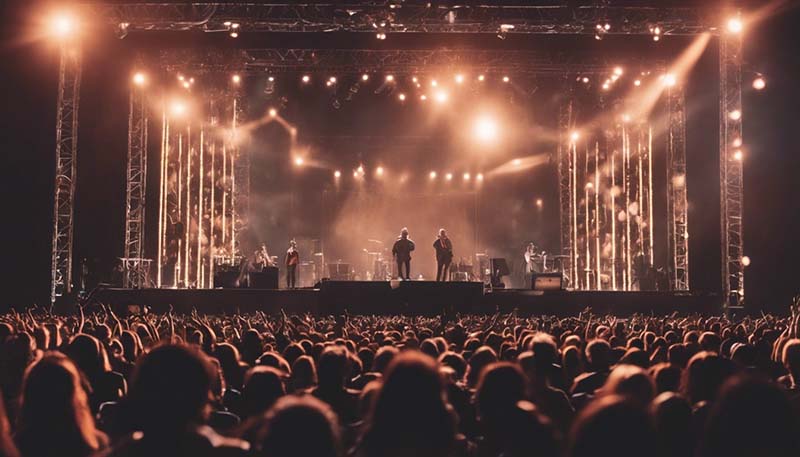The Role of Stage Design in Pop Music Concerts
Stage design plays a crucial role in pop music concerts, enhancing the overall experience for both the performers and the audience. This article delves into the various aspects of stage design, its evolution, and its impact on the music industry.
Introduction
Pop music concerts are not just about the music; they are a spectacle that engages all the senses. Stage design is a critical component of this spectacle, transforming a simple performance into an unforgettable experience. From the moment the lights dim and the first note is played, the stage design sets the tone for the entire concert.
History of Stage Design in Pop Music
The evolution of stage design in pop music can be traced back to the early 20th century when live performances began to incorporate more elaborate sets and lighting. However, it was not until the 1960s and 1970s that stage design truly came into its own, with artists like The Beatles and Pink Floyd pushing the boundaries of what was possible.
As technology advanced, so did the capabilities of stage design. The 1980s saw the introduction of large-scale video screens, pyrotechnics, and computer-controlled lighting systems, which added new dimensions to the concert experience.
Advertisement
Elements of Stage Design
Stage design encompasses a wide range of elements, including:
- Set Design: The physical structure of the stage, including backdrops, platforms, and props.
- Lighting: The use of light to create mood, highlight performers, and enhance the visual impact of the show.
- Video Projection: The integration of video content to provide a backdrop or to interact with the performance.
- Special Effects: The use of pyrotechnics, smoke, and other effects to create a dynamic and engaging environment.
- Sound Design: The audio elements that complement the visual aspects of the stage design and enhance the overall concert experience.
Role of Stage Design in Concert Experience
Stage design serves several important functions in a pop music concert:
- Immersive Experience: It creates an immersive environment that draws the audience into the world of the performance.
- Visual Storytelling: It helps to tell a story or convey a theme that complements the music.
- Artist Expression: It allows the artist to express their personality and artistic vision.
- Audience Engagement: It engages the audience by providing visual interest and enhancing the emotional impact of the music.
- Branding: It reinforces the artist's brand and creates a memorable experience that fans will associate with the artist.
Challenges and Considerations
Designing a stage for a pop music concert is a complex process that involves numerous challenges and considerations:
- Budget Constraints: Stage design must often be achieved within a limited budget.
- Technical Limitations: The design must be technically feasible and safe to implement.
- Venue Specifics: Each venue has its own unique characteristics that must be taken into account.
- Artist Collaboration: The designer must work closely with the artist to understand their vision and preferences.
- Sustainability: There is an increasing focus on creating stage designs that are environmentally sustainable.
Notable Stage Designs in Pop Music
Throughout the history of pop music, there have been several notable stage designs that have left a lasting impact:
- Michael Jackson's "Bad" Tour (1987-1989): Known for its elaborate sets and groundbreaking special effects.
- U2's "360° Tour" (2009-2011): A massive, four-legged structure known as "The Claw" that provided an intimate experience for fans, regardless of their seat.
- Beyoncé's "Formation World Tour" (2016): A visually stunning tour that featured intricate set designs and powerful imagery.
- Lady Gaga's "ArtRave: The Artpop Ball" (2014): A tour that blurred the lines between art and music, with a stage design that was as eccentric as the artist herself.
Future of Stage Design
The future of stage design in pop music is likely to be shaped by advancements in technology, including virtual reality, augmented reality, and holography. These technologies have the potential to create even more immersive and interactive experiences for concertgoers.

Additionally, there will be a continued focus on sustainability, with designers looking for ways to reduce the environmental impact of their creations. This could lead to more reusable and recyclable materials being used in stage design, as well as a greater emphasis on energy-efficient technologies.
Conclusion
Stage design is an essential element of pop music concerts, enhancing the experience for both the performers and the audience. As technology continues to evolve, so too will the possibilities for stage design, ensuring that pop music concerts remain a thrilling and unforgettable experience for years to come.
References
For further reading and resources on stage design in pop music concerts, consider the following:
- "The Art of Concert Stage Design" by Mark Fisher and Robin Simon
- "Stage Lighting Design: The Art, the Craft, the Life" by Steve Cunningham
- "Set Design: The Visual Storytelling of Film and Theatre" by Roy Williams
Comments